What is my dog trying to tell me?
If only my dog could talk …
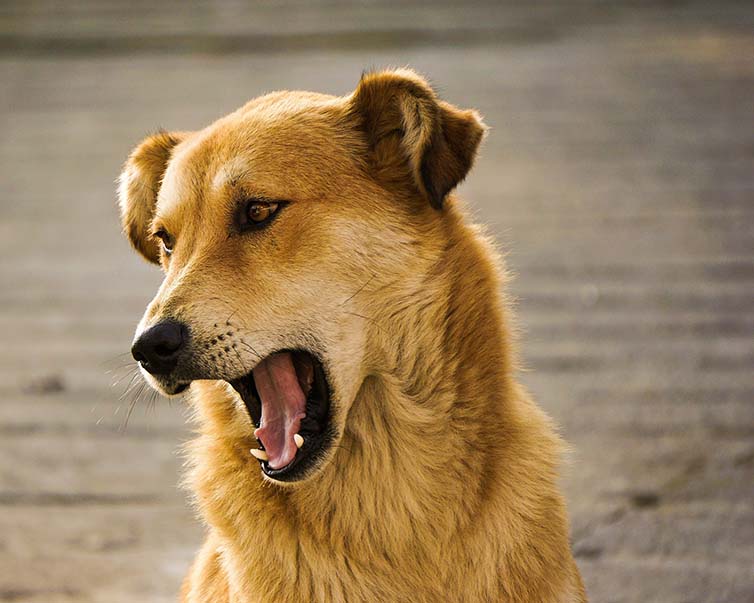
“I thought you were never coming home!”
“I’m sick to death of this boring kibble!”
“Walkies? Yes! Yes! Yes!”
“It wasn’t me. Honestly.”
“I feel like an idiot in this stupid jersey! (Or cone.)”
“V-E-T means walkies, right?”
“Yes. Your bum looks fat in those pants.”
“I feel sick.”
“I wuv you.”
“There’s a murderer at the door!”
Wouldn’t it be great if we could understand what our beloved pooches are thinking? We wouldn’t have to try to figure out what all the whining, howling, whimpering or barking is all about. We could ask their opinions. We could explain that we’re only going out for an hour. They could tell us where the pain is.
But … they DO communicate with us! Just not in a language that we can easily understand. We communicate with other humans with words, spoken or written. Dogs communicate in two main ways: by making noises in their throats and through their body language. So, obviously, it would help us and our canine companions, if we were able to understand doggy communication.
Let’s have a look at how canine body language works.
Doggy Body Language
Look at the whole dog
What do we mean by this? It includes ear and eye positions, body position and movement, tail carriage and movement and, believe it or not, facial expressions. So, a wagging tail means that Hunter (a large German Shepherd) is happy, right? And it’s safe to pat him, right?
Weeell…not necessarily. You’d be risking a bite if you assumed that Hunter was ‘safe’ and friendly. (Actually, he’s a big softie, but you can’t tell that just by a wagging tail.) What is very important when trying to figure out what Hunter is trying to ‘say’ to you, is to look at the ENTIRE dog, and the situation. For example, if Hunter’s tail is wagging; if his whole body looks stiff; if he’s crouching and if his ears are flat, and particularly if you are a stranger (the situation, or context), back off, because he’s ‘the hell in’ for some reason, or he’s simply guarding his territory and you are the undesirable alien.
There are several types of doggie communication behaviours, or signals, which will help you to know what kind of mood Hunter is in.
I’m feeling anxious

Certain situations can evoke anxiety even in the calmest canine. An article by Cummings School of Veterinary Medicine in the U.S.A. (centerforshelterdogs.tufts.edu) explains that a normally happy and relaxed dog can become extremely anxious in a shelter environment. They have noted that such dogs may pace, salivate, lick their lips, lower their stance with their ears back and wag their tail slowly while looking away from humans and, this is key, jump off the side of their kennels. An anxious dog may show more aroused/excited behaviours such as barking, pacing, circling, lunging at other dogs and humans.
But of course, it also depends on the dog’s temperament. Hershey, a Yorkshire terrier, is anxious and stressed by nature. He frantically licks windows (Yes, we said ‘windows’.) in an attempt to alleviate his almost constant nervousness. His vet has prescribed lots of different therapies, including meds and behaviour therapy, but nothing works. His frantic barking, pacing, lunging and yes, tail wagging, at basically nothing most of the time, indicate a nervous temperament and do not necessarily suggest that anything is wrong. Hershey’s mom tries desperately to do the ‘right thing’ by ignoring such behaviour as far as possible and rewarding Hershey when he calms down. It is an ongoing battle.
I’m feeling aggressive
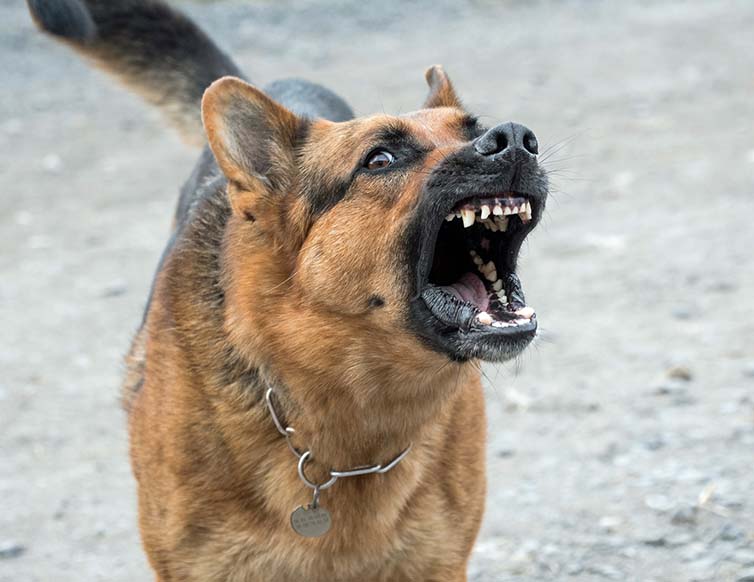
Most animals, including dogs, can be aggressive both by nature and because of certain situations, such as ill-treatment as puppies. It is in dogs’ nature to defend themselves, their owners and their territory. Dogzilla is a little Maltese terrier (the name is, of course, ironic) who is a laid-back boy by nature. However, if he perceives a threat of some kind, from a human, another dog or a situation, he feels he must protect himself and his territory, so he ‘warns’ the ‘threat’. For example, if another dog or, heaven forbid, a cat, approaches him while he’s eating, he will growl, show his teeth and stiffen. The ‘threat’ should back off before he resorts to more serious action, such as biting. Aggressive body language includes body stiffening, wide eyes showing the ‘white’, curled lips revealing teeth and gums, barking, growling and snapping.
Of course, such behaviour, whilst being undesirable in certain situations – like barking, growling and showing his teeth at granny – is obviously desirable in others. He may be protecting your home (his territory) by arousing your attention, which is often enough of a deterrant to chase burglars away.
I’m feeling scared
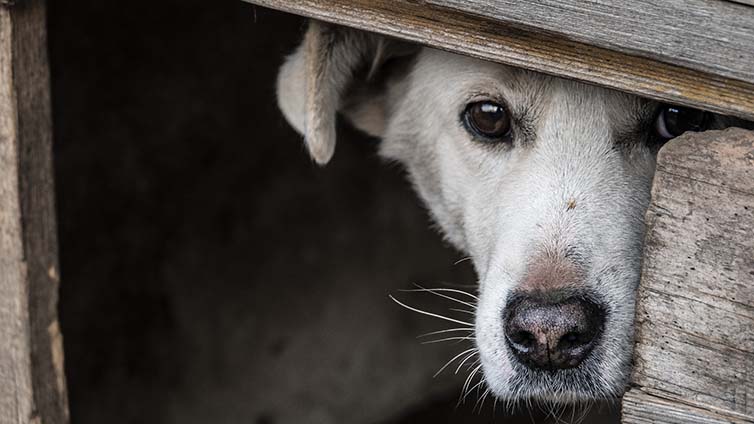
Again, we must consider the whole body of the dog here. If Mam’zelle (a large French poodle), is frightened, she may display some or all of these behaviours: licking her lips, yawning (or closed mouth), body lowered with tail in or down, ears back, avoiding eye contact, trembling or shaking. On the other hand, an absence of signals can also suggest fearfulness. For example, not eating, avoidance behaviours such as sitting in kennel, and freezing, which may progress into aggressive signals if the perceived threat approaches her.
I’m excited!
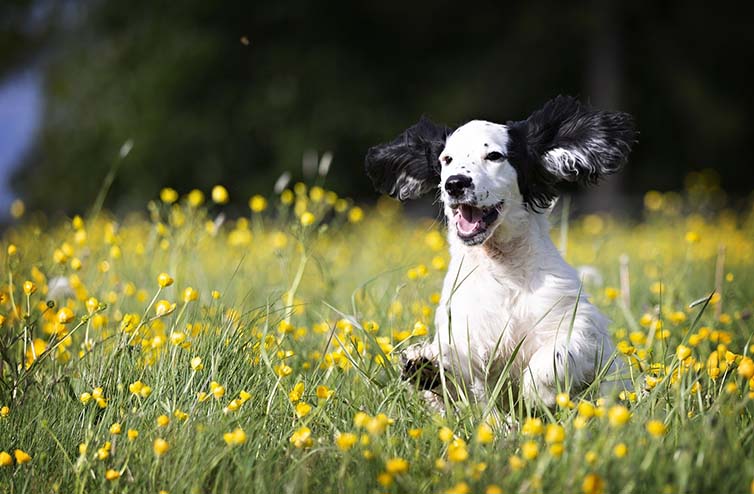
Behaviours indicating excitement, or arousal, are often a response to a person, dog or object that Mam’zelle likes. She’s very fond of her owner’s sister so she will relax her body and face, wag her tail so that it becomes a blur, jump with joy and yap, which may become a bark, when sister comes to visit. She may also ‘mouth’ which means she makes teeth contact but doesn’t bite, which may, inadvertently become a hard bite. Her fur may stand up, her ears may be erect, and her stance may be up and erect. Mam’zelle may also go into ‘play’ position: front end down, rear up.
Such behaviours can also be in response to a perceived threat, in which case they are accompanied by trembling and a tucked-in tail, with more aggressive barking.
I’m feeling relaxed
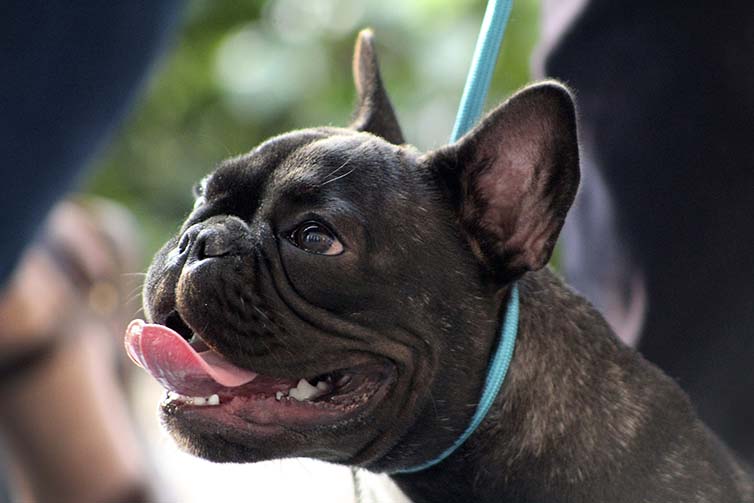
When our dogs are happy, we’re happy. If Mam’zelle is OK with the world, she will usually be lying down in a relaxed position – even on her back with her legs in the air. Her mouth may be slightly open with her head and ears in their ‘normal’ position. Her tail may be wagging, but it’s usually more of a swishing, leisurely movement.
Dogs literally live ‘in the moment’. They do not worry about the future and whether that slight altercation with Dogzilla on her walk today might escalate into a full-blown war tomorrow. Right now, Mam’zelle has a full stomach, she is warm and relaxed on her comfy cushion.
But … should she hear a movement outside, she will convert to aggressive mode in a second, informing potential burglars that here is a serious guard dog who is alert and on patrol.
Let’s have a look now at more specific behaviours and what they may indicate about how our canine companions are feeling:
Specific Behaviours
Chewing
This is a natural behaviour for dogs, which is little consolation for you when the corner of your couch is missing. However, understanding it and looking at alternative sources of ‘chewables’, will help to solve this problem.
What is he trying to tell me?
Puppies are teething and, like human babies, have painful gums. Their instinct is to alleviate the pain, and speed up the process of the tooth pushing through, by chewing on something. Adult dogs chew instinctively to keep their teeth strong and clean, but it’s also possible that they chew to relieve boredom, particularly when they are home alone.
What can be done? Instead of yelling at him, give him some options, like safe chew toys and fake bones. (No real bones, please, whether cooked or raw, because they may splinter.) If you think he may be bored, especially if you’re out all day, make sure he gets sufficient stimulation when you’re home by taking him for walks and playing with him.
Biting
We’re talking about biting people and other animals here.
What is she trying to tell me?
Biting is usually associated with aggression, but there are other reasons for biting. A dog will bite, usually as a last resort, when she feels threatened in some way. It is their final ‘weapon’ to protect themselves, you or their territory.
In the case of dogs biting children, while this is something that must be investigated and dealt with, there is always the possibility that the child has, inadvertently, hurt the dog. Children should be taught, by their parents, how to love and treat animals, from an early age. However, if it is anything more serious than a ‘nip’, then you need to consult your vet. A toy ‘from Mam’zelle’ to the child may help to alleviate the situation, in the case of an accidental nip.
It is possible that any dog who is inclined to bite has not been properly socialised as a puppy. An animal behaviourist will be able to help, as will your vet. In the case of a puppy biting, this is often their way of finding out about the world and some safe chew toys may be the answer. It is rarely because of aggression. Most puppies, thankfully, grow out of this phase.
Licking
Again, this is also a natural behaviour for dogs. But you, your family and friends, may not appreciate being licked, especially if you get your make-up removed on a regular basis. Some dogs lick often and frantically; other dogs hardly lick at all.
What is he trying to tell me?
Puppies are licked by their moms for comfort. They’ll usually lick you because they want to show that they love you – often when food is in the offering! They may also be trying to get your attention – perhaps it’s walkies time? Some dogs like the taste of your skin, especially if it’s coated with expensive Estee Lauder make-up. (Saves on make-up remover.)
Remember too that dogs’ saliva is full of anti-bacterial enzymes, so it helps to heal wounds. Try to discourage this though, as an antiseptic or anti-bacterial cream (from the vet), will work much better. Licking stitches is, of course, a very efficient way of removing them. Think: the Cone.
Licking, as with cats, is also a way of cleaning themselves. But: #catsdoitbetter.
Crying, whining and howling
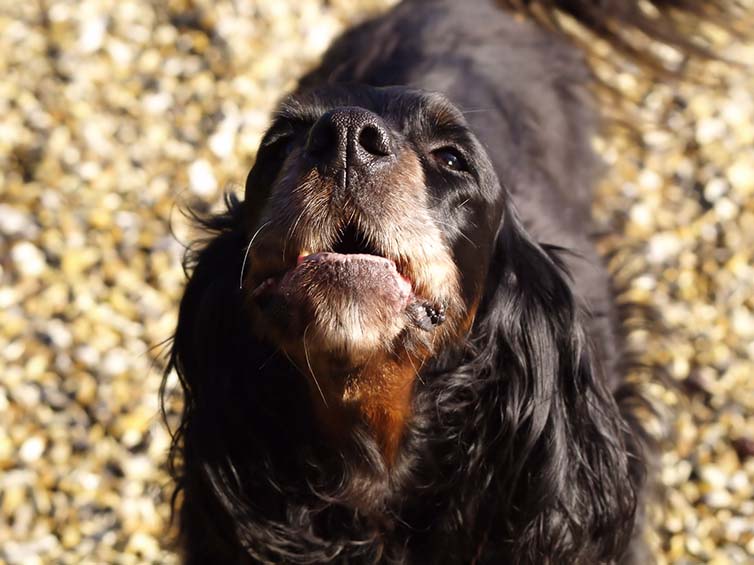
Buster (a stunning bull mastiff) has the habit of whining and crying for no apparent reason, which is driving his mom mad.
What is he trying to tell me?
Well, Buster’s not doing this for nothing. He’s trying to communicate with you. He may want to tell you that he’s thrilled that it’s dinner-time. He may want to say that he’s excited to be going on a walk. But it can also be for attention, especially if there’s a problem. He may be feeling insecure, perhaps in a new place. He may have pain. He may suffer from separation anxiety. He may want to sing along to your music.
Howling is also a way of telling you, or another dog, something. Dogs in the wild howl to communicate with other dogs. It is also often done when a dog is suffering from separation anxiety. If this is the case and if you and the family are out all day, maybe ask a neighbour to pop in now and again, or you could increase exercise and play time when you’re home.
Another way of dealing with separation anxiety is to do the ‘slowly, slowly’ approach. Start by ‘leaving home’ for a few minutes (while hiding in the garden), increasing this time each day until Buster learns that you WILL be home eventually. You could also consult your vet or an animal behaviourist.
And finally …
We hope that we have managed to give you some insight into your furry friend’s ‘language’, and that the next time his/her behaviour is different or odd, that you will be able to understand and resolve any issues.
And please don’t forget to ‘Bravecto®’ your animals! Spring is upon us and more little beasties are looking for furry homes. Prevent these tiny aliens from latching on to your pets by using Bravecto® Tick and Flea treatments, available from your vet or pet store.

Subscribe to our Newsletter
Get to know your furry friend better! Sign up for all things dog- or cat-related.
The Hairy Facts about the dreaded hairball
12 April 2021
Help! My dog’s barking mad! Volume 2
12 April 2021
Your Itchy, Scratchy Cat – All About Cat Skin Problems
12 April 2021
The Dog’s Diet: A Bone of contention?
01 April 2021
Mango Fly Worms: How to Spot and Eliminate them
Posted on November 28,2019
Managing Mange And Mites In Your Dog
Posted on June 11,2018
Why Do Cats Purr and How? Learn What Your Cat Is Saying
Posted on October 14,2020
How to Get Rid of Ear Mites in Dogs
Posted on November 06,2019









